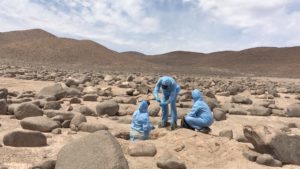The Boundaries of Life Initiative is answering fundamental questions about the diversity of life and the various forms it could take — many of which may not yet be recognized.

Our modern system for classifying life forms into kingdom, phylum, class, order, family, genus, and species was first sketched out in the eighteenth century. Three centuries later, the American scientist Carl Woese turned the scheme on its head.
Woese recognized that genetic differences between organisms, newly identified at the time, could be useful for classification. To accommodate these differences, he proposed an updated taxonomy that included three “domains” above the kingdom level: Archaea, Bacteria, and Eukarya (the latter of which includes all animals, including humans). This classification forms the modern basis of the tree of life.
Now, the Boundaries of Life (BoL) Initiative, a collaboration of scientists from Global Viral, Stanford, and the California Institute of Technology, is again attempting to restructure our knowledge of life on earth by asking a provocative question: What if there is more than one tree? What if life evolved more than once?
The initiative, led by Nathan Wolfe, a consulting professor of human biology at Stanford University, is collecting a rich array of samples from extreme environments to search for forms of life that lie outside our current knowledge of biology. Supported by a three-year, $4.5 million grant from the John Templeton Foundation, the BoL team of researchers, students, and postdocs is pursuing new research techniques to detect novel life forms that might be missed by conventional tests.
Organisms with such alternative biochemistries might be hiding right under our noses. “We may not have to go to Mars to find new life,” says Wolfe, a principal investigator for BoL and director of Global Viral, which manages the project. “With the Boundaries of Life initiative, we’ve begun one of the most profound exercises and journeys we could ever imagine — exploring for other life forms — and we’re doing it right here on Earth.”
Wolfe is joined at BoL by fellow principal investigators Stephen Quake (bioengineering, Stanford), and Rob Phillips and Grant Jensen (biophysics, California Institute of Technology).
Fringe Life in Exotic Locales
Most life as we know it can persist only in a narrow range of environmental conditions. BoL is examining potential habitats at the far ends of these parameters where extreme temperature, aridity, pH, and other factors are hostile to life. The team’s goal is to gauge how far life can push the envelope.
BoL researchers are obtaining some new habitat samples, but many analyses leverage samples gathered by partnering organizations worldwide. Targeted sites include deserts in Chile, volcanic ground in Hawaii, hot springs in Yellowstone National Park, permafrost from Alaska, and hydrothermal vents on the ocean floor.
The search even extends into the bodies of those with compromised immune systems, such as recent organ transplant recipients. Some kinds of bacteria and viruses that are found in these individuals are not found in other humans, and thus remain largely unknown.
The Search Has Barely Begun
 BoL researchers use deep genomic sequencing, staining and sorting, and electron microscopy, among other advanced techniques, to detect the signatures and structure of conventional, DNA- and RNA-based life, as well as potentially unconventional “shadow life.” All these data are being incorporated into existing, publicly available online libraries documenting life’s rich diversity, which will serve as a resource for future investigations.
BoL researchers use deep genomic sequencing, staining and sorting, and electron microscopy, among other advanced techniques, to detect the signatures and structure of conventional, DNA- and RNA-based life, as well as potentially unconventional “shadow life.” All these data are being incorporated into existing, publicly available online libraries documenting life’s rich diversity, which will serve as a resource for future investigations.
There is still much work to be done. Wolfe and colleagues estimate that in searching for biological structures, the total area deeply imaged at the microscopic level by electron microscopes on our entire planet to date merely amounts to the surface area of a single leaf.
In other words, there is a gargantuan amount of Earthly territory left to comb for clues about this phenomena we call life.
“BoL is a long-term objective,” says Wolfe. “We are really trying to answer fundamental questions.”